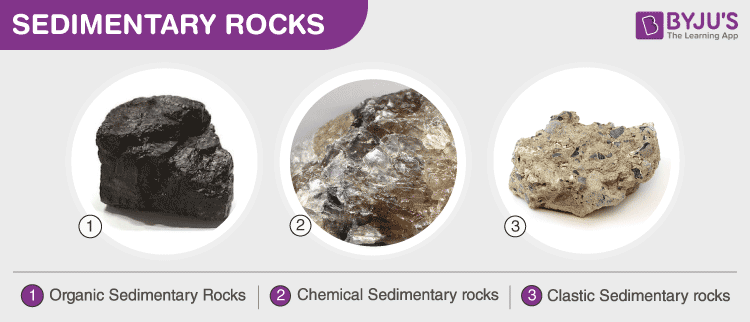Sedimentary rocks are created by accumulating existing rocks or fragments of extinct organisms on the Earth’s surface. Deep sediment burial causes sediment to get compressed and cemented, resulting in sedimentary rock. Let’s study sedimentary rocks in this article.
| Table of Contents |
How Are Sedimentary Rocks formed?
Sedimentary rocks are formed by the deposition and subsequent cementation of the material at the Earth’s surface within the bodies of water. These rocks are formed in four ways:
- Deposition of weathered remains of other rocks
- Accumulation and the consolidation of sediments
- Deposition of the results of biogenic activity
- Precipitation from solution.
What Is Sedimentation?
Sedimentation is the combined name for all the processes that cause organic and mineral particles to settle. The particle that helps in forming the sedimentary rock is called sediment. This sediment is formed with the help of erosion and weathering from the source area and is then transported to the deposition place by the wind, water, ice and glaciers, which are agents of denudation.
The best way to examine the rock type is to check the sediment grain size and variation. Its texture refers to the features and arrangements of the grain in such sediments. Its structure is present in rock beds and under surfaces which help record the paleocurrent and has deposited in the rocks. It covers the continent of the earth’s crust, but the total contribution of these rocks is estimated to be 8% of the total volume of the crust.
Examples:
Some common sedimentary rocks are:
- Limestone
- Chalk
- Clay
- Sandstone
- Shale
These rocks cover 75% of the earth’s surface.
Types of Sedimentary Rocks
The sedimentary rocks are classified into three different types: Organic, Clastic and Chemical Sedimentary Rocks.

Types of Sedimentary Rocks
Organic Sedimentary Rocks
This rock type mainly comprises coal and limestones, which are formed due to the accumulation and deposition of dead plants and animals in rock layers.
Clastic Sedimentary Rocks
This type of rock is formed when rock layers are formed due to the mechanical weathering of different rock types.
Chemical Sedimentary Rocks
This type of rock is created when minerals that are present in rock forms undergo a chemical reaction that causes them to cool as precipitates over time before changing back to rock form.
Check out the video below for more information on sedimentary, igneous and metamorphic rocks

You may also want to check out these topics given below!
Uses of Sedimentary Rocks
The use of sedimentary rock can be found in most buildings and monuments. Some uses of this type of rock are provided below.
- Limestone is used to make cement.
- Limestone and sandstone are used for building stones
- Quartz is a type of sedimentary rock which is used to make glass.
- Rock gypsum is used to make plaster.
Natural gas, oil, coal, uranium, and other energy resources are formed in and come from sedimentary rocks.
For more information on sedimentary rocks and their types, watch the below video

Interesting Facts about Sedimentary Rock
Sedimentary rocks are formed by sediment that is deposited over time. Some sedimentary rock facts are provided below.
- Flint is a hard, sedimentary form of the mineral quartz.
- Sedimentary rocks cover most of the Earth’s rocky surface, but they only make up a very small percentage of the planet’s crust.
- They often contain fossils of plants and animals millions of years old.
- Limestone is often made from the fossilized remains of ocean life that died millions of years ago.
- These rocks form layers called strata which can often be seen in exposed cliffs.
Frequently Asked Questions – FAQs
What are some examples of sedimentary rock?
When and where do sedimentary rocks form?
How are sedimentary rocks formed?
What distinguishes a sedimentary rock?
What are the qualities of sedimentary rocks?
Stay tuned with BYJU’S for more such interesting articles. Also, register to “BYJU’S-The Learning App” for loads of interactive, engaging physics-related videos and unlimited academic assistance.

Are Chemical Sedimentary rocks made up from the huge group of salt?
Yes, they are made of a huge group of salts such as calcium chloride and calcium sulphate.